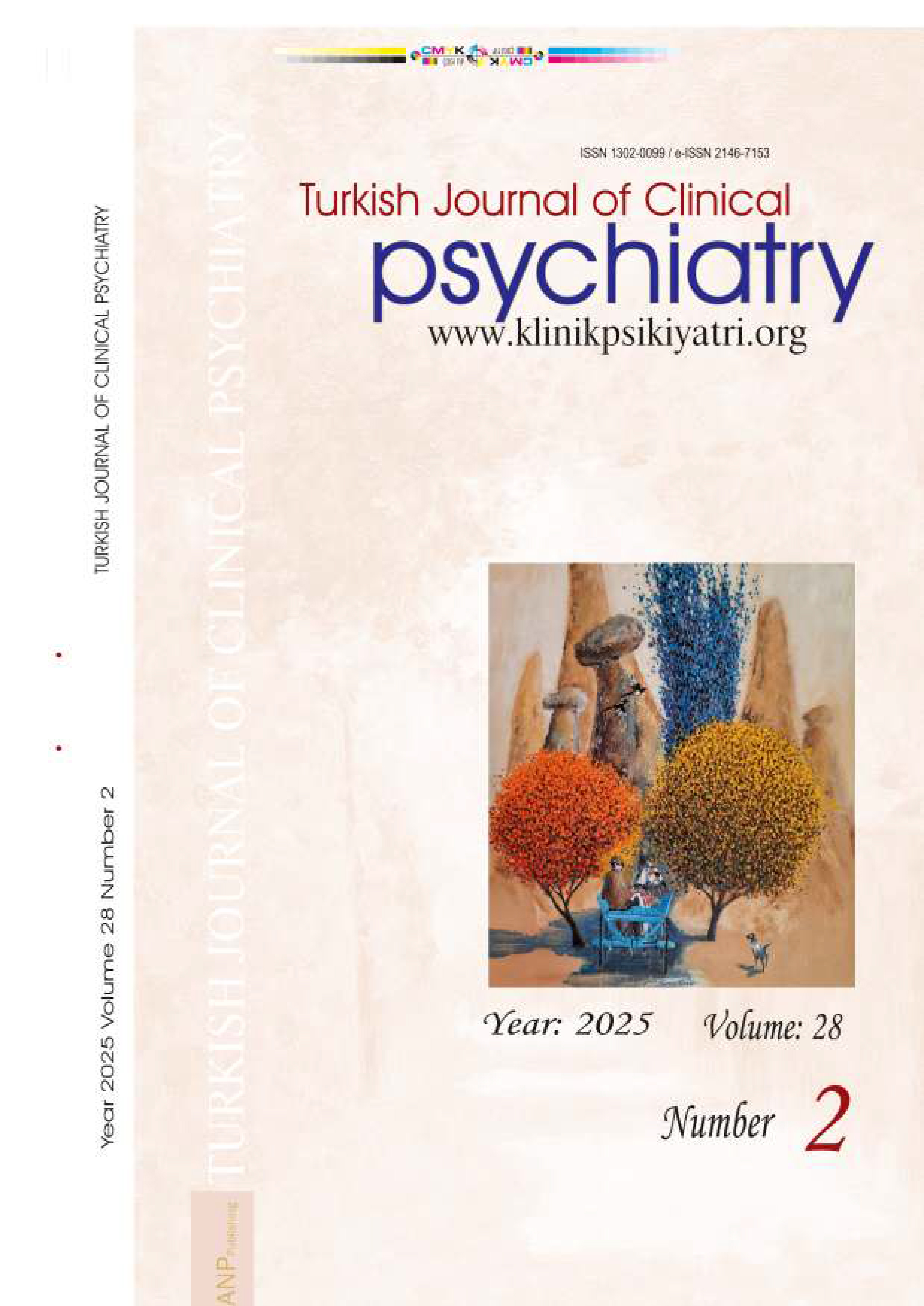





Volume: 21 Issue: 3 - 2018
| EDITORIAL | |
| 1. | Editorial Mehmet Yumru doi: 10.5505/kpd.2018.32659 Pages 208 - 209 Abstract | |
| RESEARCH ARTICLE | |
| 2. | Development, implementation and results of Objective Structured Clinical Exam in Psychiatric Association of Turkey Board Exam (eng) Ozlem Surel Karabilgin Ozturkcu, Ozlem Kuman Tuncel, Damla Isman Haznedaroglu doi: 10.5505/kpd.2018.89421 Pages 210 - 221 INTRODUCTION: The aim of this study, is to present the process and results of OSCE in Psychiatric Association of Turkey Board Exam-PATBE. METHODS: Six stationed OSCE, in which Standardized Patient-SP took role on five stations, were used as an exam method. These stations were planned for assessing the skills of taking history, psychiatric examination, differential diagnosis, making treatment plans and informing the patient. On the sixth station, the examinees are asked to write a forensic psychiatric report. Phases of OSCE were: preparing the blueprint, preparing the SPs’ scenario for each station, preparing the examinee's instructions, preparing the observer's instructions and the evaluation guide, SP education, training of observers, pilot implementation, implementation and evaluation of results. The examinees are expected to achieve at least 30% success in each station and 50% success in all stations. RESULTS: 116 examinees participated the exam between 2006-2016 and 91.4% succeeded in the OSCE exam. In feedback forms, examinees stated that the exam is moderately difficult; yet, the content of the exam is in line with the scope of their specialty training and is suitable for evaluating an expert. DISCUSSION AND CONCLUSION: Positive feedbacks from the examinees indicated the efficiency of the exam. The preparation, implementation and evaluation of results of OSCE require considerable time and manpower. OSCE can be used as a valuable test method for psychiatric board certification. |
| 3. | Evaluation of the ganglion cell layer thickness in children with attention deficit hyperactivity disorder and comorbid oppositional defiant disorder (eng) Şahin Bodur, Halil Kara, Burak Açıkel, Erdoğan Yaşar doi: 10.5505/kpd.2018.37450 Pages 222 - 230 INTRODUCTION: We aimed to compare the Retinal Nerve Fiber Layer (RNFL), ganglion cell layer (GCL), and the optic nerve thicknesses (ONT) of children diagnosed with Attention Deficit Hyperactivity Disorder (ADHD) to a healthy control group; and the possible worse effect of the Oppositional Defiant Disorder (ODD). METHODS: 31 patients, (n=16 ADHD and n=15 ADHD+ODD) and a control group of 31 participants included. The Conners' Teachers Rating Scale and the Conners' Parent Rating Scale were used for the severity of the symptoms in children. Ophthalmologic measurements performed with optic coherence tomography device. RESULTS: In this study, different ophthalmologic measurements (RNFL, GCL and optic nerve thicknesses) are compared between ADHD children and controls. Results show primarily bilateral thinner GCL in ADHD children compared to controls, which is the first demonstration. Optic nerve thicknesses of right eye inferior quadrant and left eye superior quadrant, as well as mean optic nerve thickness of left eye, and furthermore both eyes total GCL thickness measurement averages with also their thicknesses in superior, inferior area of patient group were found as statistically lower (p< 0,05) than control group. The measured thinning of RNFL wasn’t statistically significant for both eyes in patient group. DISCUSSION AND CONCLUSION: In patients diagnosed with ADHD, thinning of the GCL and optical nerve thicknesses were found statistically significant compared to the control group, whereas the thinning of RNFL was only numerical. ODD comorbidity was thought to have no additional effect on thinning. This may lead to the idea that the negative effect of the ODD on the neurodegenerative process may be assessed with larger sample studies. |
| 4. | Temperament and character dimensions, marital adjustment, and sexual satisfaction in couples with sexual dysfunction (eng) Cennet Şafak Öztürk, Haluk Arkar doi: 10.5505/kpd.2018.86548 Pages 231 - 244 INTRODUCTION: The objective of the study is to investigate the differences in temperament and character dimensions, marital adjustment and sexual satisfaction between the couples with and without sexual dysfunction (SD). METHODS: The study group consists of 78 married women and 23 married men with SD diagnosis according to DSM-IV-TR diagnostic criteria and also their spouses (n=202). The comparison group is composed of married couples without SD (n=200). The participants were applied Personal Information Form, Temperament and Character Inventory (TCI), Golombok-Rust Inventory of Sexual Satisfaction (GRISS), Dyadic Adjustment Scale (DAS). RESULTS: The couples with SD were observed to have higher cooperativeness and self-transcendence and lower self-directedness scores than those of the comparison group. The women partners in the couples with SD were found to take higher harm avoidance and lower self-directedness scores than the women in comparison group. Dyadic satisfaction, affectional expression and DAS total scores in the couples with SD were seen to be significantly less than those of the couples in the comparison group. It was found out that the women in the couples with SD took significantly higher scores in GRISS total score and all subscales, and men in the couples with SD took significantly higher scores in GRISS total score and subscales of satisfaction, avoidance, premature ejaculation and impotence than those in the comparison group. DISCUSSION AND CONCLUSION: It can be said that cyclothymic character, harm avoidance and self-directedness were the risk factors for SD. Marital adjustment and sexual satisfaction are insufficient in the couples with SD. |
| 5. | The relationship of suicide attempt story and stress coping style among the patients with opioid substitution therapy (tur) Vahap Karabulut, Cüneyt Evren doi: 10.5505/kpd.2018.94830 Pages 245 - 253 INTRODUCTION: In this study, it was aimed to investigate the relationship between stress coping styles and story of suicide attempt among a group of patients with buprenorphine maintenance treatment. METHODS: This study evaluated 90 patients who were hospitalized in the Alcohol and Substance Research Treatment and Training Center. All patients were evaluated using a semi-structured sociodemographic and clinical information form. At the same time with this form, substance abuse patterns and some clinical variables such as story of suicide attempt were also questioned. In addition, each patient was given State- Trait Anxiety Inventory, Beck Depression İnventory and the Coping Inventory for Stressful Situations. RESULTS: The mean age of the patients was 26.3, duration of training was 9.45, age of first drug use was 16.1 years, duration of heroin use was 6.4 years. 33.3% of the patients had attempted suicide at least once. Patients who had a suicide attempt story had significantly lower age at onset (16.8 versus 14.8, p = 0.035, respectively). There was no statistically significant difference in emotion-oriented coping and avoidance-oriented coping scores while the task-oriented coping score was lower in those who had suicide attempt stories (25.33 versus 22.37, p = 0.019, respectively). The STAI-II scale score was significantly higher in those who had suicide attempt stories (43.4 versus 50.1, p <0.001, respectively). The difference between the two groups in terms of BDI and STAI-I scales was not statistically significant. DISCUSSION AND CONCLUSION: A third of the sample had at least one suicide attempt story. Those who attempt suicide use less the task-oriented coping strategies. According to the results of the study, it can be said that attempts to improve task-oriented coping skills in response to stressful conditions and to reduce the trait anxiety will have an important place in preventing suicidal behavior. |
| 6. | Clinical characteristics, adjustment between the couples and the quality of sexual life of married women who are exposed to physical domestic violence (tur) Ava Şirin Tav, Bülent Kadri Gültekin, Beyza Sarıöz Arpacıoğlu doi: 10.5505/kpd.2018.66375 Pages 254 - 260 INTRODUCTION: The present study was performed to assess the adjustment between the couples in married women who were exposed to domestic violence and the effects of domestic violence on the quality of sexual life. METHODS: The study included 162 married women between the ages of 18 and 65 years, who were consecutively admitted to the general psychiatry outpatient clinic of Ministry of Health Erenköy Research and Education Hospital for Psychiatric and Neurological Diseases between 01.06.2017 and 01.09.2017. Structured psychiatric interview (SCID-I) according to the DSM-IV diagnostic criteria were performed all individuals participating in the study. The patients included in the study completed the sociodemografic data form, domestic violence questionnaire form, Dyadic Adjustment Scale for Measurement of Marital Quality with Turkish Couples and Quality of Sexual Life Questionnaire. RESULTS: Among the patients who participated in the study, 62 (38.27%) of them had been exposed to domestic physical violence. While 42.0% of those who had not been exposed to domestic physical violence had an arranged/involuntary marriage, the percentage of those who had an arranged marriage among women who were exposed to domestic violence was 61.3%. Women who were not exposed to domestic physical violence had significantly higher scores from the Quality of Sexual Life Questionnaire than that of those who were exposed to domestic physical violence (p<0.001). Furthermore, agreement, satisfaction, adjustment and total subscales of the Dyadic Adjustment Scale were found to be significantly higher in women who were not exposed to domestic physical violence (p<0.001). When the psychiatric diagnosis of the participants was assessed, it was found that the percentage of women with depression was 66% and anxiety disorder was 30% in those who were not exposed to domestic violence, while the percentage of women with depression was 77.4%, and those with anxiety disorder was 16.1% in those who were exposed to domestic physical violence (p>0.05) DISCUSSION AND CONCLUSION: We found in the present study that adjustment between the couples and quality of sexual life was quite low in women who were exposed physical domestic violence. It is quite important that people who are dealing with mental health should not only assess the symptoms of the disease but also the components of the woman’s social and cultural background and include domestic violence in the anamnesis. |
| 7. | Comparison of traumatic symptoms severity of adolescents educated in some state high schools in Istanbul and exposed to traumatic and distressing events (tur) Aynur Eren Gümüş, Özlem Karaırmak doi: 10.5505/kpd.2018.64326 Pages 261 - 270 INTRODUCTION: The purpose of this study is to compare the severity of posttraumatic stress symptoms between adolescents who were exposed to traumatic events and those who were exposed to distressing events in the previous year. Besides, the severity of the posttraumatic stress symptoms with respect to the event characteristics (namely interpersonal and not interpersonal), and gender was investigated. METHODS: Study group was composed of 781 adolescents in total. From among them, 325 adolescents exposed to traumatic or distressing events in the previous year were selected. The age range of the participants was between 14-19 years (16.24 ±1.02). Data were collected through The Post Traumatic Diagnostic Scale and The Traumatic Experiences Information Form. RESULTS: According to results, the total severity scores of traumatic symptoms, total score of re-experiencing, avoidance and arousal subscales did not show difference with respect to the type of trauma (traumatic event, distressing event and both traumatic and distressing event). Besides, the group of participants exposed to interpersonal trauma had significantly higher scores on the severity of traumatic symptoms than those exposed to non-interpersonal trauma. Finally, women had significantly higher scores on the severity of traumatic symptoms, as well as on re-experiencing, avoidance and arousal subscales. DISCUSSION AND CONCLUSION: Findings suggest that negative life events which happened within the previous year, regardless of meeting the diagnostic criteria, may create a risk for PTSD for adolescents suffering from highly severe traumatic symptoms, which is a critical factor in effective intervention planning. Additionally, the findings contributes to the discussion about the expanding the A Criteria. |
| 8. | The gender roles attitudes of medicals students: A cross-sectional study (tur) Ali Ercan Altınöz, Nagihan Günal, Şengül Tosun Altınöz, Ferdi Köşger, Altan Eşsizoğlu doi: 10.5505/kpd.2018.08860 Pages 271 - 277 INTRODUCTION: Gender roles; refers to the roles traditionally associated with women and men. In studies conducted to determine the attitudes of university students towards gender roles in our country, it has been shown in different studies that male students have a more traditional view of gender roles than female students. In this study, it was aimed to determine the attitudes of university students studying gender roles and to investigate the effect of medical education on these attitudes. METHODS: This study is cross-sectional and conducted with the first and sixth year students who are studying medicine at Eskisehir Osmangazi University (ESOGÜ) Faculty of Medicine. Sociodemographic form and Gender Roles Attitude Scale (TCRSS) were applied to participants. RESULTS: There was a not significant difference between the first and sixth grades in terms of total TCRSS score and subscale scores (p> 0.05). There was no difference between the first and sixth grades (p> 0.05) in terms of averages of the scale scores for males (p> 0.05) when the scores of the groups were compared with the scores of the TCRSS and subscales after the participants had separated by sex. In the females, 6th-grade students had significantly higher traditional gender subscale scores (p = 0.033). DISCUSSION AND CONCLUSION: This study is, to our knowledge, the first study in the literature investigating attitudes towards gender roles in medical students in our country. In terms of content, it is recommended that medical education be organized to provide a transformative contribution to the attitudes of students towards gender roles. |
| 9. | Analysis of the psychiatric consultations for inpatients and from the emergency room in a university hospital: A comparison with studies from Turkey (tur) Burcu Eser, Sedat Batmaz, Emrah Songur, Mesut Yıldız, Esma Akpınar Aslan doi: 10.5505/kpd.2018.53824 Pages 278 - 289 INTRODUCTION: The aim of this research was to assess the characteristics of the consultations required in a psychiatric department of a university hospital, and the distribution of psychiatric disorders in hospitalized patients and patients admitted to the emergency room. METHODS: In the study, the data of 539 patients 18 years or older (48.67 ± 20.91 years) (46.8% women) who were hospitalized and who presented to the emergency room between 01/01/2015 and 31/12/2015, and for whom a psychiatric consultation was requested were recorded onto a structured form. Patients' electronic databases were reviewed retrospectively for the specified date range. Descriptive statistical analyzes (frequency of data, distribution, mean, standard deviation) were performed for the data examined in the study. RESULTS: Medical departments (42.9%), surgical departments (31.7%) and the emergency medicine department (25.4%) were the most frequently psychiatric consultation requesting departments. The most frequent requests for consultation were agitation (15.4%), depressive symptoms and signs (14.7%) and suicide attempts (12.2%). The most frequent psychiatric diagnoses were depressive disorders (19.5%), delirium (18.2%) and schizophrenia and other psychotic disorders (7.4%). Musculoskeletal diseases (17.4%), mental disorders (15.0%), oncologic diseases (14.1%) and suicide attempts (12.2%) were the primary diagnoses of patients. DISCUSSION AND CONCLUSION: Consultation and liaison psychiatry services have an important role in our relationship with other departments in medicine. Priority to training of depressive disorders, delirium and suicide attempts should be offered to healthcare providers working in these departments. |
| 10. | Decision-making behavior from adolescence through elderly and its relationship with executive functions (tur) Serra Şandor doi: 10.5505/kpd.2018.28291 Pages 290 - 300 INTRODUCTION: In present study, age related changes in decision-making behavior of healthy participants through the years beginning from adolescence and through later maturity as assessed by Iowa Gambling Test and performance differences between gender and age groups were examined and were compared in a cross-sectional design. Considering the confounding effects of participants’ executive functions and their impulsivity levels decision-making performances, the correlations with these variables were also investigated. METHODS: Decision-making behavior of 157 healthy participants with age ranges 13-80 were divided into 4 groups (13-17, 18-35, 36-60, 60 and above). Executive functions were assessed by Wisconsin Card Sorting Test and impulsivity was assessed by Barratt Impulsivity Inventory. RESULTS: Between-subjects effects revealed that both gender and age had significant effects on decision-making performance. According to paired comparisons, 18-35 age group had significantly higher total net scores than the 13-17 age group. Male participants had significantly higher total net scores than the female participants. Despite each group increased their IGT scores within themselves throughout the test, 13-17 and 60 above groups did not achieve the levels of other groups’ scores. No significant correlations were found between impulsivity and decision-making performance, a weak significant correlation was found between perseverative errors and total net scores of decision-making test. DISCUSSION AND CONCLUSION: As expected, an inverted U-shaped developmental pattern of decision-making behavior, which was characterized by an increase in performance that became evident in adolescence and proceeds through early adulthood and which was subsequently followed by a decrease in performance through late maturity was determined in this study. |
| REVIEW | |
| 11. | Collective trauma cycle: The healing role of reconciliation, forgiveness and restorative justice in collective traumas (tur) Ayten Zara doi: 10.5505/kpd.2018.36449 Pages 301 - 311 Although collective traumas have a serious impact on the mental health of the community, the real challenge is solving the problem of how to live together after all committed persecutions. In countries like Rwanda, South Africa, Yugoslavia, Chile and Uruguay, trauma victims often had to live side by side with torturers, which has led to almost insurmountable problems in the community's reconstruction process and the healing of collective wounds had to deal with issues such as truth, justice, compensation, restoration, forgiveness and reconciliation. Collective trauma can be solved with both individual and societal studies to prevent generational transmission. For peace building through breaking the cycle of victimization and aggression, it is necessary to approach ethnic and transnational conflicts with a peaceful problem-solving approach involving truth, understanding, reconciliation, forgiveness and restorative justice. Above all, to break the chain that transfers the feelings of hatred, shame and guilt to one another, it is necessary the victims, the offenders and their partners to meet each other and their consciences. |
| CASE REPORT | |
| 12. | Memory deficits and frontal lobe syndrome associated with bilateral globus pallidus lesions in a patient with synthetic cannabinoid use (tur) Merve Çukurova, Tonguç Demir Berkol, Pınar Çetinay Aydın, Fatma Sibel Bayramoğlu doi: 10.5505/kpd.2018.08769 Pages 312 - 319 Major strategic functions of the basal ganglia are thought to involve the fine tuning and modulation of the activity of the most parts of the frontal cortex, control of the skeleto-motor and oculo-motor movements, and modulation of the limbic system and associative functions. In this case report, a patient with a 10-year history of synthetic cannabinoid use and bilateral symmetrical hyperintense lesions of the globus pallidus in T2 weighed images following head trauma is described in conjunction clinical signs of global amnesia, behavioral changes consistent with frontal lobe syndrome, and reduced affect display, without any movement disorders. To the best of our knowledge, this patients represents the first case who had bilateral globus pallidus lesions due to synthetic cannabinoid use together with frontal lobe syndrome-like clinical signs without movement disorder. This case report points out to the fact that synthetic cannabinoid use may lead to development of bilateral globus pallidus lesions, which may be associated with amnesia without movement disorder, suggesting that this clinical picture may have resulted from the interruption of pathways between the prefrontal cortex and basal ganglia. |










